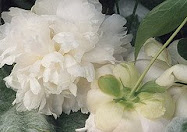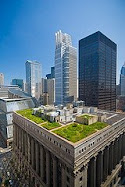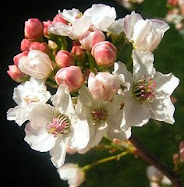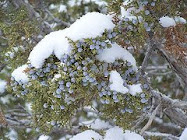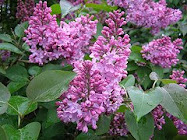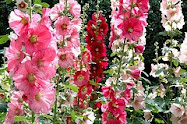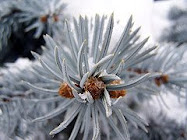
First the gardener must decide, which species of the thousands of trees to plant? Three factors held the most sway in my choices – appearance, including color, shape, and what fruits, nuts or flowers might be borne; durability, including expected lifespan, how rapidly growth and thus shade occur; and finally, suitability for the temperatures, moisture and other elements of the northern Michigan coastal four seasons. Whether to plant trees was never a question, given the tremendous beauty and shelter from Mother Nature's occasional fits and furies which trees provide, and the inimitable good they confer upon the environment by cleaning the air of toxins and creating oxygen. One mature oak tree, for instance, creates all the oxygen needed by 10 humans.
The only tree in this garden that didn't measure up to all the selection criteria was a cedar, which needed a lot more water and less wind than the site or the gardener could offer, and which segued into the great forest in the sky after a painful struggle of just two years. The best performers to date, on the other hand, are the Cleveland ornamental pear and the white spire river birch.
Everyone knows how pretty birch trees are (see Flickr.com photo at top of this entry), which their shaggy white bark, sharp green leaves that slowly transform to butter yellow in autumn, and graceful, pendulous branches. It's a source of amazement that the river birch in the front yard went from a five-foot sapling with the trunk span of a stout walking stick to a 30-foot high lush shade-maker with a strapping, foot-and-a-half trunk span, in just five years. The Cleveland pear, maybe a little less familiar, gets covered in lovely, fragrant white blossoms every May, has a fetching natural triangular shape and very dense, full leaf development. It bears tiny little ornamental pears about the size of a dime, which the birds love but require not one whit of harvesting or cleaning up. Its other great feature is its ability to hold onto leaves and kelly green color right into November, even in a climate where Jack Frost usually pays his first visits early in October. When the color shift comes, the leaves gradually progress in a gorgeous pageant from shiny bright green to lime, to lemon yellow, to russet, and finally into a dark, burgundy red. Baring gale-force windstorms, most of the leaves stay on the branches into early- to mid-December, well after every other tree is winter naked.
Just this year, an article unveiled the unhappy information that ornamental pears, because all the branches grow from a single (non-branching) trunk, are vulnerable to the trunk splitting from the top downwards, if strong winds pull at the dense leafage. Which strong winds certainly do in this garden, and alas and alack, this spring when admiring the tree's growth and giving it's trunk an affectionate pat or two, indeed a newly developed split in the trunk was discovered. The split starts at the top of the trunk (about six feet from the ground), and extends downward about a foot and a half, so not yet into the lower core of the trunk. The pear is such a favorite, and with its branches now stands about 20 feet high, so it was a heart breaker to descry the breach that could mean the beginning of the end for this five-year old.
Unwilling to accept such a sad fate for one of the garden's inaugural trees, a stint with the thinking cap in place determined two courses of remedial action. First, a tough rubber brace was secured slightly loosely, with room for a little play, breath, and growth, around the trunk just at the mid-point of the split. The hope is that the brace will support the trunk against the tugging of the wind and keep the split from proceeding further down the trunk. The brace is about the length and a little thicker than a bungee cord, made of very hard black rubber, and was among the garden stuff in the garage, though what it is really for or what it is called are pieces of information lost to the mists of time.
Second, about a dozen whole garlic cloves were planted around the base of the tree. Garlic is an almost miraculous herb, with very robust viral and fungal healing powers (not to mention that it wards off grazing deer even better than it spooks vampires, and it makes roses flourish). Once in another garden, a young plum tree fell sick with a fungus called “Witch's Finger,” which basically strangles new branches with a sticky, black, gnarled-finger-looking growth. Reasoning, or hoping, that the garlic cure which can halt Montezuma's revenge, cure cold sores, fight cancers and knock down colds in humans might also be beneficial to a tree, the affected branches were loped off the plum and garlic planted all around its base. It healed, survived and took to growing again. Thus it seemed that a dose of garlic for the pear might help the raw, vulnerable edges of the split in the trunk to heal over, as well. These two treatments (or maybe more accurately, experiments), were effected in May of this year, and as of this writing in November, the split has not progressed further down the trunk, and the split's edges do seem to be hardening off. Time will tell, as with all things in the garden, if it's sufficient to preserve the Cleveland pear.
The rest of the trees planted the first year all grace the backyard, spaced around its perimeter, with the conifers in the back westerly corner. The October glory maple lives up to its name by turning a brilliant, flame red each fall, and has grown pretty well, now standing some 15 feet high after five years.
Nut-bearing trees seem to grow more slowly than other deciduous types. This has definitely been true for the red oak, which has branched out fairly nicely, but gained only maybe a foot of height and half-a-foot of trunk span across five years. The white pines and Colorado spruce followed the old cliché of plant growth, to wit, “first year sleep, second year creep, third year leap,” and didn't increase very measurably in height or width till their third or even fourth year, but as of this summer took to leaping up and out very nicely. Probably took them awhile to decide they could put up with the rackety, ever-recurring winds that swoop through the yard in all seasons, especially from their northwest back corner. Maybe one day they will actually achieve enough mass to block some of the fierce winter winds that charge up from that corner on a regular basis to dump snow loads on my back sidewalk.
The crab apple tree grows well and is a pink picture of blossoms every May, as well as a fall treat for the birds with its claret red fruits. Some of the latter even survive to throw a handful of bright color into the winter-white landscape of snow and ice. Because spring blossoms just finish in delight the view of any landscape, two additional trees put into the garden are a Fuji apple tree in the back, frilly in white each spring, and a self-pollinating (hooray!) Tartarian black cherry tree in the easement out front. The apple is two years old now, and has produced one apple each year -- watching this space for more productivity as maturity ripens! The cherry was planted this summer, one has sky-high hopes of someday plucking that most favored fruit from it.
Lastly, two years ago a quaking aspen was placed, stripling of twig size, in the front yard, and true to its eager nature, now reaches 15 feet in height with a hand-span, palest mint green, sturdy trunk. It, like the birch, transforms its grass-green, heart-shaped leaves over a long month or more, October into November, to a golden yellow. This tree takes its name from the way the leaves flip back and forth in the wind, giving the appearance of “quaking” and raising a soft, shuffling kind of sound, so it talks as good as it looks.
Trees frame-up the garden, draw the eye toward vistas, cosset the spirit with their robust handsomeness and several bounties of fruit, nuts, canopy, solid wooden bones. They seem calm, they reassure, they seem wise. Unlike many other garden dwellers, with a modicum of nurturing they live and reward their stewards for a long, long time. They'll harbor a tree fort and allow swings to sway from their arms. To climb one and sit hidden, daydreaming upon a branch, is to thumb one's nose at gravity and to soar just a little. Trees are nature's crowning glory.
 Fall and winter are not the gardener's favorite seasons. Nothing in the plant world grows in fall and winter except underground, out of sight. While the autumn rainy season and winter's deep snowfalls are welcome for the replenishing water supply they bring to the lakes, rivers, streams and plants, their cloud cover and ever-diminishing daily hours of sunshine do put a crimp in the spirit. A surfeit of backache-inducing snow shoveling looms in the immediate future. Hunters with lethal firearms are abroad around the hiking trails. Death and dormancy are the dominant themes.
Fall and winter are not the gardener's favorite seasons. Nothing in the plant world grows in fall and winter except underground, out of sight. While the autumn rainy season and winter's deep snowfalls are welcome for the replenishing water supply they bring to the lakes, rivers, streams and plants, their cloud cover and ever-diminishing daily hours of sunshine do put a crimp in the spirit. A surfeit of backache-inducing snow shoveling looms in the immediate future. Hunters with lethal firearms are abroad around the hiking trails. Death and dormancy are the dominant themes.



